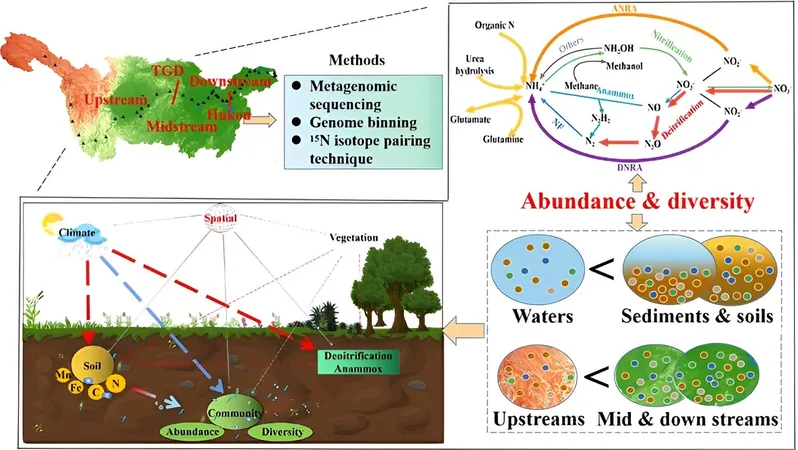
Groundbreaking Study Uncovers Vital Link Between Microbial Communities and Nitrogen Removal in Yangtze River
2024-10-08
Author: John Tan
Introduction
Excess nitrogen (N) has become a pressing issue for inland water bodies and marine ecosystems, leading to a range of harmful environmental consequences. Understanding the pathways for nitrogen removal is essential for maintaining ecological balance in both aquatic and terrestrial environments. This is where functional microbes play a pivotal role in developing effective nitrogen management strategies to help protect downstream water sources.
Research Overview
A recent study from researchers at Wuhan Botanical Garden, spearheaded by Professors Liu Wenzhi and Xiong Xiang, delved deep into this critical area by conducting advanced metagenomic sequencing and genome binning. The research focused on the abundance and diversity of nitrogen-cycling genes found in surface water, channel sediments, and riparian soils along the heavily nitrogen-polluted Yangtze River.
Key Findings
Published in the esteemed journal Water Research, their paper titled "Metagenomic insights into nitrogen-cycling microbial communities and their relationships with nitrogen removal potential in the Yangtze River," reveals astonishing findings. The team discovered 121 metagenome-assembled genomes (MAGs) pivotal to nitrogen-cycling processes, with the main contributors identified as belonging to the Proteobacteria phylum. Specifically, the classes Alphaproteobacteria and Gammaproteobacteria emerged as dominant agents of nitrogen cycling within these polluted waters.
Differences in Nitrogen-Cycling Genes
The study highlighted striking differences in the abundance and diversity of nitrogen-cycling genes between soil/sediment and water samples, and also between upstream and mid-downstream sites. This suggests that geographical variables and limitations on microbial dispersal significantly influence the distribution of nitrogen-cycling genes in this ecosystem.
Correlation with Nitrogen Removal
Moreover, the research revealed a strong correlation between the rates of nitrogen removal processes and the abundance or diversity of specific nitrogen-cycling genes. Factors such as climate variables and the physicochemical properties of the soil were found to directly and indirectly regulate denitrification and anammox processes by impacting microbial gene expression.
Conclusion
These groundbreaking findings fill an essential knowledge void regarding the geographic distribution and environmental influences on nitrogen-cycling microorganisms in river ecosystems, viewed through the lens of metagenomic analysis. This vital research not only enhances our understanding of nitrogen management in the Yangtze River but also sets the stage for future studies aimed at mitigating the environmental ramifications of nutrient pollution.
Implications for the Future
As the world grapples with climate change and its impact on water quality, this study serves as a crucial reminder of the delicate balance between microbial health and environmental stability. The implications of these findings could be profound, paving the way for improved strategies to manage nitrogen pollution and protect invaluable water resources globally.



 Brasil (PT)
Brasil (PT)
 Canada (EN)
Canada (EN)
 Chile (ES)
Chile (ES)
 España (ES)
España (ES)
 France (FR)
France (FR)
 Hong Kong (EN)
Hong Kong (EN)
 Italia (IT)
Italia (IT)
 日本 (JA)
日本 (JA)
 Magyarország (HU)
Magyarország (HU)
 Norge (NO)
Norge (NO)
 Polska (PL)
Polska (PL)
 Schweiz (DE)
Schweiz (DE)
 Singapore (EN)
Singapore (EN)
 Sverige (SV)
Sverige (SV)
 Suomi (FI)
Suomi (FI)
 Türkiye (TR)
Türkiye (TR)